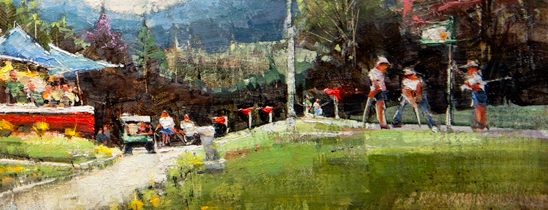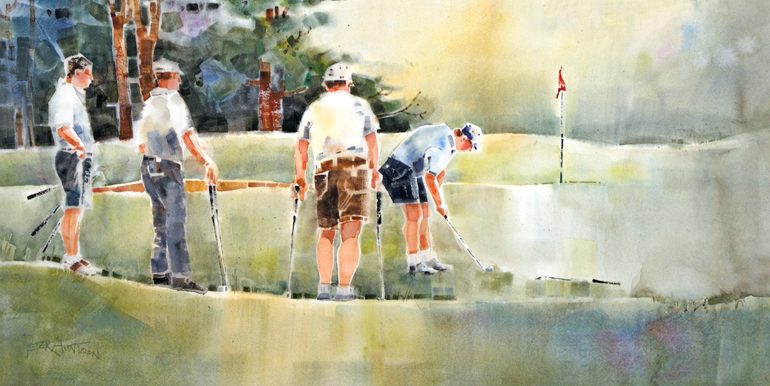Stratton Mountain Resort’s Golf Course Superintendent Shawn Murnaghan speaks on the past, present, and future of Stratton’s golf course and explains the craft of golf course maintenance.

Golf Course is a rejuvenating and memorable experience. As a cool breeze rustles through the leaves of the majestic trees that stand on the sides of the well-trimmed greens, sunlight reflects off of the clear and rippling surface of the lake that lies in the middle of the course.
“Not every golf course has views as gorgeous as this,” says Shawn Murnaghan. “There’s a lot of work that goes into making sure that the course itself stays as healthy and beautiful as the surrounding scenery.”
Murnaghan is Head Golf Course Superintendent for Stratton Mountain Resort. He has over three decades of experience in the field of golf course maintenance. As he drives through the Stratton course on his trusty utility vehicle, he surveys the greens with a diligent and observant eye. Every day that he shows up at the Stratton golf course presents him with new challenges – as well as new opportunities to create an optimal golfing experience for both local residents and visiting vacationers.
According to Murnaghan, the original 18 holes at the Stratton course were designed by a renowned golf course architect by the name of Geoffrey Cornish. After several years of construction, the original course was completed in 1964. Today, these 18 holes comprise two of Stratton’s three nine-hole courses: the “Lake” course and the “Mountain” course. In the earlier years of his career, Cornish studied under the legendary golf course architect Robert Trent Jones, Sr. Highlights of Jones’ sprawling design portfolio include the Peachtree Golf Club in Atlanta, the putting green at the White House, and the 18 championship-caliber courses that make up the world-famous “Robert Trent Jones Golf Trail” in Alabama.
As his career continued to flourish, Geoffrey Cornish also went on to become a prolific and award-winning golf course designer. Known for his traditional golf course designs, Cornish often opted to design his courses to conform to the lay of the land rather than move large amounts of dirt around to suit his vision. By doing so, Cornish took advantage of the natural features of the terrain to build courses that were both stunningly aesthetic and intuitively playable.
In the same way that Cornish trained under the expert tutelage of Robert Trent Jones, Sr., he also helped to educate younger architects on the finer points of golf course design. After the initial eighteen holes for the Stratton golf course were completed, one of Cornish’s talented protégés, Brian Silva, returned to design the final nine holes at Stratton years later. The nine holes that Silva helped to complete became Stratton’s third and final nine-hole “Forest” course. This brought the grand total of holes at the Stratton golf course to 27.
Murnaghan notes that the addition of the third nine-hole course allowed Stratton to create a rich and varied experience for returning golfers. “We split up the 27 holes into an eighteen-hole course and a nine-hole course, and we rotate which two nine-hole courses make up our eighteen-hole course on a day-to-day basis. For example, one could come here one day to play eighteen holes on the lake course and then the mountain course, then come back the next day and play eighteen holes on the mountain course and then the forest course. It’s our way of making sure that things stay fresh here.”

In order to make sure the grass remains equally as fresh and inviting as the course layout, Murnaghan and his team of mechanics and maintenance workers go to extensive lengths to ensure the continued health of their greens. By working tirelessly to preserve the natural integrity of the course’s landscape and maintain its ecological balance, Murnaghan and his team have been able to create a first-class golfing experience at the Stratton course that appeals to experts and novices alike.
“You want to set up a golf course so that people can have a good time,” says Murnaghan. “Here at Stratton, we pride ourselves on our ability to provide a family-friendly golf experience that’s both satisfying to seasoned players and accessible to the newcomers. Geoffrey Cornish always said that he wanted the first hole of any of his golf courses to be like ‘a gentle handshake.’ If you stand on the first tee on Stratton’s lake course and take in the view, it’s nice and wide and open. There’s a big and welcoming green, and a huge landing area on the first hole. It lets you get your bearings and start your round off on the right foot. To me, that’s a great start to a solid day of golf.”
For golfers who are new to the sport, Murnaghan recommends that they stop in at the Pro Shop first to consult with the on-staff PGA professional golfer, Mike Bailey. “Mike is incredibly friendly and great with families. He can provide people with all of the advice that’s necessary to get started with gear, lessons and anything else they need.” Murnaghan adds that for golfers who are still refining their skills, it’s best to start off at the driving range. After becoming comfortable with the basic mechanics, they can then book a tee time at the nine-hole course. “The nine-hole course at Stratton has a much more relaxed pace than the eighteen-hole course. You can enjoy yourself without worrying about holding up more experienced golfers behind you.”
Murnaghan is very proud of his extensive knowledge of grass maintenance. He strongly believes that although many championship-level golf course designers have touted “fast greens” as the ideal standard, the speed at which a ball travels on the grass is not always the best indicator of a healthy green. “In the past ten to twenty years, there’s been a real focus in the industry on creating golf courses with greens that allow golf balls to travel very fast,” notes Murnaghan.” I personally think that speed is a poor way to judge how healthy a green really is. To me, it’s much more crucial to make sure that a ball is rolling ‘true.’ When I hit my ball, I don’t want it to slide back and forth and bounce. I want it to stay on the linear path that I chose for it. If the greens at Stratton are doing that, I think I’ve done my job pretty well in terms of grass upkeep.”

To make sure the grass remains in tip-top shape, Murnaghan and his team embark on a calculated series of timed mowing campaigns throughout the course of the spring and summer seasons. They also make use of advanced mowing techniques such as “verticutting.” “Grass is normally cut with mowing blades moving horizontally to the grass,” Murnaghan elaborates. “With ‘verticutting,’ we actually use a machine that has about 100 vertically-placed blades on a shaft. That type of treatment really gives the grass a nice and even trim.”
For the “topdressing” component of Stratton’s grass maintenance program, Murnaghan and his team immediately follow up the “verticutting” phase by topping the grass with a light-to-heavy coating of sand. “The ‘topdressing’ stage really removes a lot of the friction of the leaf blades,” says Murnaghan. “It makes the turf smoother and firmer so that the ground doesn’t squish or give as much
underneath – especially after repeated rains and foot traffic.”
To further compact the ground, Murnaghan employs a tool known as a “greens roller”, which he describes as a “four-foot-long non-tapered baseball bat that’s attached to a moving machine.” In order to ensure that the grass remains even, Murnaghan’s maintenance team rolls every inch of the greens two to three times a week depending on certain factors, such as weather, temperature, and the amount of play that the course has seen.
Murnaghan says that different chemical compounds that are present in the soil can play a large part in determining the overall health and longevity of the grass. “We get soil samples of our greens tested every three to four years, and the amount of nitrogen used on all of Vermont’s golf courses is extensively monitored by the state government. Proper nitrogen levels are critical, as are proper potassium and phosphorus levels. It’s crucially important to address the ‘nutrient demand’ of the soil. These compounds all nourish the soil, but if any one of them are out of balance, it can have disastrous results.”
In order to properly portion out the nitrogen, Murnaghan’s team either uses nitrogen granules or directly sprays the nitrogen onto the grass depending on the situation. When the nitrogen is sprayed directly on the leaf blades, it is taken in by the leaves, but some nitrogen still makes it down to the roots. According to Murnaghan, sometimes the weather can have an effect on the rate at which the nitrogen is released. “If it gets hot or rains a lot, you’ll get a sudden release of granular fertilizers, and you’ll get a sudden flush of growth. You have to account for this and read the greens and their growth patterns properly and cut accordingly. If you don’t do that, your greens will
become thick to the point that they impede the movement of the ball.
Because of this, I usually start the season off with a minimal granular application of nitrogen, and then proceed to go apply additional nitrogen via spray over the course of the season. Over time, I have learned to read the cues of the greens and the grass. If you notice ‘dollar spots’ on the green, which are referred to as such because they look like silver dollars, it may be due to a lack of nutrients. If you notice a brown patch, it may be due to excessive nitrogen.”
Murnaghan says that one of the most frequently asked questions he encounters from visitors is “Where do the long dark and light stripes on the grass on the golf course come from?” Murnaghan explains: “All of our mowers have rollers on them. By raising or lowering the rollers, you control the height that the grass is cut at. The rollers also press the leaves away from the mower. If you see a ‘stripe’ on the course that looks lighter, that means that the leaf blades in that ‘stripe’ are all facing away from you. If they’re darker, it means that the ends of the blades have been bent to face towards you. The stripes are a natural byproduct of the mowers proceeding back and forth as they maintain the course.”
In order to curtail excessive water use and guarantee that the grass is properly hydrated, Murnaghan and his team go to each tee, green, and fairway on a daily basis to check for dry spots and spots that have been overly saturated. “If anything got too much water the night before, we dial back the amount of water that spot receives through our irrigation system. Much like with the nitrogen distribution, you have to read the terrain and use your senses to judge what course of action is best to take. It’s something that comes with time and experience.”
Murnaghan says that each season brings unique challenges in terms of golf course maintenance at Stratton. “Due to Vermont’s fairly unique ecosystem, a meteorological phenomenon of freeze and thaw cycles creates dangerous circumstances for the health of the grass during the winter. After snow falls, warmer temperatures during certain winter days will allow the snow to melt into liquid water. That water then seeps into the surface of the turf on the green, and then freezes later on at night. Day after day, this phenomenon of continuous freezing and thawing builds thick coats of ice over the grass throughout the duration of the winter season. Plants are 80% water, and a plant’s highly-absorbent cell walls can only hold so much frozen water before they explode. If that happens, you see a lot of dead grass on the course as a result. The beginning of the spring season is when we assess the extent of that type of damage. Sometimes, we will come back on the course after the winter and see that there has been minimal damage over the winter season. Other times, we will return to over a dozen ‘dead greens.’ It all depends on the weather over the winter.”
During the summertime, the focus changes to maintaining the grass and grooming the course to ideal standards. “We want golfers who come towards the end of the season in August to have the same playing conditions as golfers who come early in the season in May,” says Murnaghan. “You seed the soil, you water and feed the grass, and you look around for grubs and other invasive insects – such as annual hyperodes weevils – and take whatever preventative measures are necessary to try to eradicate them. After the summer ends, preparations then begin for the winter season.”
To prepare for the winter season, Murnaghan’s team starts the process of “aerification” in the early fall. During the aerification process, small holes are made in the ground to allow air to reach the roots of the grass. This is done so that the grass does not suffocate when the soil is compacted during the wintertime. Ideally, aerification is done two to three weeks before the first frost. The irrigation system is then mechanically blown out by a compressor to get rid of all of the water in the pipe joints, and the greens are all covered with a series of large tarps.
Murnaghan is a firm believer in the fact that every golfer who enjoys a round at the Stratton Golf Course is a temporary steward of the course, and as such, should adhere to certain rules of golf etiquette. “One of the best ways to make sure that a golf course remains in good condition is to do your part in maintaining the course. If you leave a noticeable ball mark or divot, there are repair tools that are available at the shop that are very easy to use. In order to repair golf ball marks, you want to find the direction from which the ball hit the green. You go behind the angle of approach, and pull the ground and grass back in the direction from which the ball came. You then tap the grass down as you play, which helps to re-solidify the turf and keep the surface true. Our maintenance team goes around and rakes the sand bunkers several times a week. Sometimes we do it by hand, and sometimes mechanically. Occasionally, people get their ball trapped in a bunker, take their bunker shot, and they put their feet in the sand, which leaves a deep impression. It’s very important that people take a moment to rake the bunker with the rake tools that we leave near every sand trap. It just takes a moment, and it ensures that the next player will not have to try to hit their ball out of a deep and compacted foot hole that the last player didn’t take the time to rake.”
In terms of divot maintenance, Murnaghan insists that the best course of action that a golfer can take after knocking a clod of turf off of the surface is to put the clod back where they found it. They must then press down on it with their foot to re-solidify it. “In the future, we also plan on equipping every golf cart with ‘divot bottles,’” says Murnaghan. “Divot bottles are containers that are full of sand. The idea is that you can pour the sand on top of a dislodged clod after you put it back in the spot where you found it. That way, you can just replace the clod, pour some sand on it, tap it with your foot, and go on your way.”
Murnaghan also believes that it’s important to remember to be considerate when driving golf carts throughout the course. “If people cut down on the amount of time that they spent driving down the fairways, it would greatly improve the quality of turf for the next player on the course. It’s best to make a note of where your golf ball falls, then drive the cart down the side path and make a 90-degree turn onto the fairway near where the ball is. That way, you can still enjoy the comfort and ease of the cart without excessively damaging the grass and turf.”
As Murnaghan sees it, golf etiquette at its essence boils down to a belief system of empathy and consideration that he holds very dearly himself. “When I go out golfing, I always want to make sure I’m doing everything that I can to help the next golfer make the most of their experience. I bring that same attitude every day to the maintenance work that I do here at the course. If, at the end of a long day, I can look back and know that I’ve made a positive difference and helped someone enjoy their time here at the course, it makes all of my hard work worth it.”
ALL THE DETAILS
stratton.com

